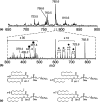New applications of mass spectrometry in lipid analysis
- PMID: 21632539
- PMCID: PMC3138261
- DOI: 10.1074/jbc.R111.233478
New applications of mass spectrometry in lipid analysis
Abstract
Mass spectrometry has emerged as a powerful tool for the analysis of all lipids. Lipidomic analysis of biological systems using various approaches is now possible with a quantitative measurement of hundreds of lipid molecular species. Although availability of reference and internal standards lags behind the field, approaches using stable isotope-labeled derivative tagging permit precise determination of specific phospholipids in an experimental series. The use of reactivity of ozone has enabled assessment of double bond positions in fatty acyl groups even when species remain in complex lipid mixtures. Rapid scanning tandem mass spectrometers are capable of quantitative analysis of hundreds of targeted lipids at high sensitivity in a single on-line chromatographic separation. Imaging mass spectrometry of lipids in tissues has opened new insights into the distribution of lipid molecular species with promising application to study pathophysiological events and diseases.
Figures



Comment in
-
Thematic minireview series on biological applications of mass spectrometry.J Biol Chem. 2011 Jul 22;286(29):25417. doi: 10.1074/jbc.R111.266700. Epub 2011 Jun 1. J Biol Chem. 2011. PMID: 21632545 Free PMC article.
References
-
- Ryhage R., Stenhagen E. (1960) J. Lipid Res. 1, 361–390 - PubMed
-
- Granström E., Samuelsson B. (1969) J. Am. Chem. Soc. 91, 3398–3400 - PubMed
-
- VanLear G. E., McLafferty F. W. (1969) Annu. Rev. Biochem. 38, 289–322 - PubMed
-
- Barber M., Bordoli R. S., Sedgwick R. D., Tyler A. M. (1981) Nature 293, 270–275
-
- Murphy R. C., Mathews W. R., Rokach J., Fenselau C. (1982) Prostaglandins 23, 201–206 - PubMed
Publication types
MeSH terms
Substances
Grants and funding
LinkOut - more resources
Full Text Sources

